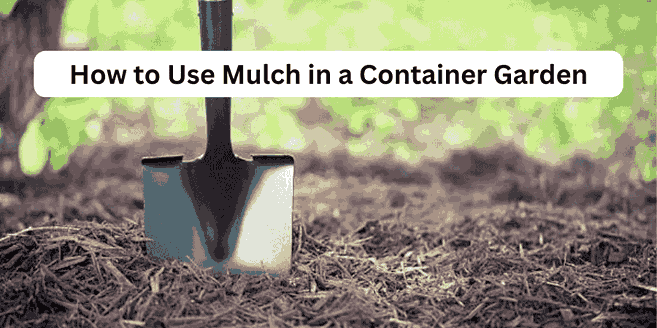Mulch is an essential tool for keeping your container garden healthy. It’s a simple layer of organic material like bark, straw, or leaves placed on top of the soil.
Adding a layer of natural material helps the soil stay moist, reducing the need for frequent watering. It also serves as a protective cover, keeping roots cool and shielded from harsh weather conditions.
Using mulch in potted plants brings many benefits. It improves soil health by adding nutrients as it breaks down. This enriches the soil and supports better plant growth.
It also helps reduce weeds, allowing your plants to get all the nutrients they need without competition.
In this article, we’ll explain how to use mulch effectively in your container garden. We will look at its key benefits and share tips on choosing the right type.

Table of Contents
ToggleWhy Your Garden Loves Mulch
Mulch adds a simple layer to your containers and planters, resting on the soil surface much like a natural forest floor.
Acting as a protective cover, it neatly wraps around the base of your plants, giving your garden a tidy and cohesive look. It’s versatile, fitting perfectly in raised bed gardens, flower gardens, and even hanging baskets.
When you spread this natural cover, it enhances your garden’s aesthetic, connecting each planter and basket into a seamless design. With every addition, your garden feels more inviting, blending elements together to create a harmonious, nature-inspired space right at home.
Benefits of Mulch for Container Gardens
Placing a layer over the soil helps create a stable environment for plants, improving soil quality and offering essential protection.
It supports plant growth by regulating the conditions within the pot. This simple addition can significantly enhance your gardening efforts.
Check out the table below to see how it can elevate your container gardening experience:
| Benefit | Description |
| Moderates Soil Temperature | Mulch insulates the soil, keeping it cooler in summer and warmer in winter, which is essential for root protection. |
| Conserves Moisture | Mulch helps retain soil moisture, reducing the need for frequent watering. However, be careful not to overwater your plants. If you suspect you’ve overdone it, you can fix overwatered plants. |
| Weed Control | A proper layer of mulch can effectively block sunlight, helping to prevent weed growth which competes with plants for nutrients. |
| Improves Soil Fertility | Organic mulches decompose over time, adding nutrients back into the soil and improving its structure. |
| Pest Deterrence | Some types of mulch, such as cedar or pecan shells, naturally repel certain pests and insects, protecting the plants. |
Best Mulch for Container Gardens: Choosing the Right Type
Using mulch in a container garden supports plant vitality and growth. It keeps the soil moist, stops weeds, and improves plants’ growth. But choosing the right mulch depends on where your plants are.
- For Outdoor Potted Plants
For potted plants, different types of mulch can work well. Bark mulch is great because it looks nice and breaks down slowly. Straw is light and easy to spread, keeping the soil cool. Compost adds nutrients to the soil as it breaks down, making it a good choice.
- For Potted Vegetables
When growing potted vegetables, choose a mulch that is safe for food. Straw is popular because it keeps the soil warm and moist. Grass clippings work too, but make sure they are free from chemicals. Shredded leaves are another great option, adding natural nutrients as they decompose.
- For Indoor Plants
Indoor plants need special mulch to look nice and keep moisture in. Coconut coir is light and holds water well, making it perfect for indoor use. Pebbles are another great choice, adding a decorative look while helping the soil retain water.
How to Use Mulch in Container Garden: Step-by-Step Guide
Adding a protective layer to your container garden can enhance plant growth and keep the soil in great condition. By adding this, you can also enhance the overall appearance of your garden, making it look neat and well-maintained. Follow these steps to use it effectively.
Step 1: Choose the Right Type for Your Plants
Select materials that suit your plants. For veggies, organic options like shredded leaves or bark work well. For flowers, small stones or pebbles are a good choice.
Step 2: Clean Your Containers
Start with a tidy space. Remove old leaves, dead plants, and any weeds. A clean container ensures that your plants stay healthy.
Step 3: Water Thoroughly First
Always water the soil before adding any covering. Moist soil keeps the layer stable and helps retain water longer.
Step 4: Apply Evenly Around Plants
Spread a layer, about 1-2 inches thick, around the plants. Leave some space around the stems to prevent rotting.
Step 5: Keep It Maintained
Check regularly. Add fresh material when it breaks down or gets blown away. This keeps your garden looking its best.
Step 6: Don’t Cover Stems Too Much
Avoid piling it too high around stems. This can lead to rot or attract unwanted pests. Keep the layer balanced and neat.
Tips for Mulching Container Plants Effectively
Using mulch is an excellent way to retain moisture and improve plant health in your container garden. Moreover, combining mulch with proper soil layering techniques ensures better drainage and root development. As a result, your plants will thrive with both moisture control and nutrient-rich soil.
| Mulch Type | Key Benefits | Usage Tips | Ideal For |
| Bark Chips | Retains moisture, keeps soil cool | Spread 1-2 inches, avoid piling on stems | Flowering plants, shrubs |
| Straw | Apply evenly, and replace often | Enriches soil looks decorative | Vegetables, herbs |
| Small Rocks | Prevents erosion, keeps soil dry | Use sparingly, best in dry conditions | Cacti, succulents |
| Cocoa Bean Hulls | Mix lightly into the soil before planting | Thin layer, avoid wet clumps | All-purpose, especially flowers |
| Compost | Boosts nutrients, retains water | Place on top, avoid touching stems | Heavy feeders, vegetables |
| Pine Needles | Acidifies soil, prevents weeds | Thin layer, best for acid-loving plants | Berries, azaleas |
| Pebbles | Enhances drainage, keeps roots dry | Acidifies soil prevents weeds | Orchids, succulents |
FAQ’s
Q: What Is the Best Thing to Put in the Bottom of Planters?
A: The best thing to put in the bottom of planters is broken pieces of chipped crockery or small pieces of old pots. These help with drainage and prevent compost loss, keeping the soil in place and stopping water from clogging.
Q: What Should I Put Down Before Mulching?
A: Before you start mulching, clear the area of old leaves and weeds. If you’re unable to pull out all the weeds, put a layer of fabric at the bottom of your container. This fabric stops weeds from growing while still letting water flow down easily.
Q: Should I Water the Mulch After Putting It Down?
A: Yes, you should water the mulch after putting it down. Watering helps the mulch settle into the soil, prevents it from blowing away, and allows it to push into place. This step helps your garden reach its best, keeping the soil moist and healthy.
Q: What Is the Best Time to Put Mulch?
A: The best time to apply mulch is in spring when the soil is warmed and weeds haven’t fully emerged. Avoid mulching too early in winter, as it can delay the soil from warming. Wait until the ground is thawed to get the best results.
Q: What Is the Best Way to Spread Mulch?
A: Use a shovel or hands to spread the mulch around plants, keeping it even. Place a thin layer over the soil, using a rake to smooth it. Put fabric or plastic sheeting under the mulch to control weeds better. Keep mulch away from stems to avoid rot.
Conclusion
Mulch is highly beneficial for container gardens. It helps the soil stay wet, stops weeds from growing, and protects roots from hot and cold weather. This simple layer can make a big difference in how your plants grow.
Try different mulches like bark, compost, or straw to see what suits your plants best. Each type of mulch has unique benefits, so explore and find the best match for your garden.
Start using mulch today and watch your container garden flourish!

